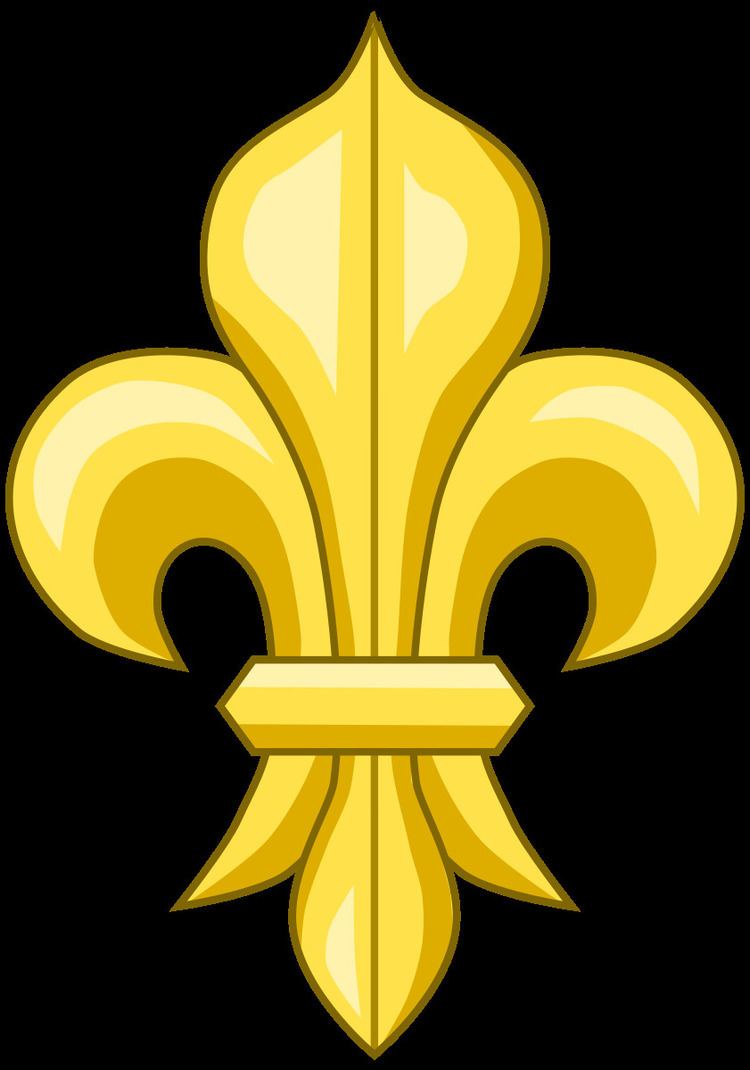 | ||
Escutcheon RF, standing for République française | ||
French heraldry is the use of heraldic symbols in France. Although it had a considerable history, existing from the 11th century, such formality has largely died out in France, as far as regulated personal heraldry is concerned. Civic heraldry on the other hand remains a visible part of daily life.
Contents
- Characteristics
- National Emblem of France
- Fleur de lys
- Arms of major cities
- Regions of France
- Dpartments
- References
The role of the herald (héraut) in France declined in the 17th century. Today the law recognises both assumed and inherited arms, considering them under law to be equivalent to a visual representation of a name, and given the same protections. However, there is no central registry of arms; in case of dispute, the individual who can prove the longest right to the blazon must be decided in court.
Many of the terms in international heraldry come from French.
Characteristics
Like the British system of heraldry, the French follow the Rule of Tinctures. This states that there are two types of Tinctures (heraldic colors): the colors Sable (black), Gules (red), Vert (green) and Azure (blue) and metals Or (gold or yellow) and Argent (silver or white). For sake of visibility (the whole point of the system), no Charges of a color can be used on a field of a color and no Charges of a metal can be used on a field of a metal, nor can the divisions of the field be color-on-color or metal-on-metal. Arms that do not follow the Rule of Tinctures are referred to as Armes pour enquérir (a "Coat of Arms to be investigated").
French heraldry has a set system of crown and coronets. Supporters are not linked with any rank or title, unlike the coronets, and are far less common than in other forms of European heraldry, such as English heraldry. Even the Royal Arms' angelic supporters are not shown in most depictions. Crests are rare in modern depictions, again in contrast to England.
National Emblem of France
The current emblem of France has been a symbol of France since 1953, although it does not have any legal status as an official coat of arms. It appears on the cover of French passports and was originally adopted by the French Foreign Ministry as a symbol for use by diplomatic and consular missions in 1912 using a design drawn up by the sculptor Jules-Clément Chaplain.
In 1953, France received a request from the United Nations for a copy of the national coat of arms to be displayed alongside the coats of arms of other member states in its assembly chamber. An interministerial commission requested Robert Louis (1902–1965), heraldic artist, to produce a version of the Chaplain design. This did not, however, constitute an adoption of an official coat of arms by the Republic.
Technically speaking, it is an emblem rather than a coat of arms, since it does not respect heraldic rules—heraldry being seen as an aristocratic art, and therefore associated with the Ancien Régime. The emblem consists of:
Fleur-de-lys
The fleur-de-lys (or fleur-de-lis, plural: fleurs-de-lis; /ˌflɜːrdəˈliː/, [ˌflœː(ʀ)dəˈlɪs] in Quebec French), translated from French as "lily flower") is a stylized design of either an iris or a lily that is now used purely decoratively as well as symbolically, or it may be "at one and the same time political, dynastic, artistic, emblematic and symbolic", especially in heraldry.
While the fleur-de-lis has appeared on countless European coats of arms and flags over the centuries, it is particularly associated with the French monarchy on a historical context, and nowadays with the Spanish monarchy and the Grand Duchy of Luxembourg as the only remaining monarchs of the House of Bourbon.
It is an enduring symbol of France that appears on French postage stamps but has not been adopted officially by any of the French republics.
Arms of major cities
All cities within France have coats of arms; these are often intertwined with local traditions over history.
Regions of France
Each region of France has its own coat of arms, although usage varies:
Départments
Few départments have official arms. There may be substantial disagreements with this table.
